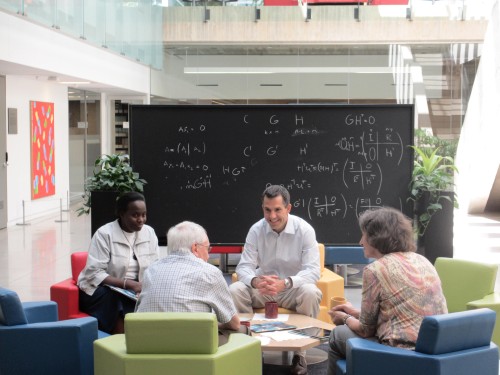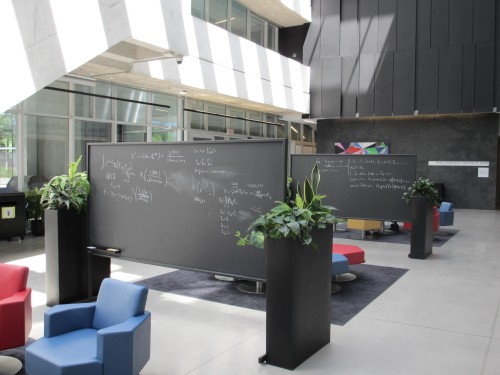
Blackboards and equations galore at the PI.
By Hamish Johnston in Canada’s Quantum Valley
Today I am living the dream, at least for many theoretical physicists. I have my very own office at the Perimeter Institute (PI) for Theoretical Physics in Waterloo, Ontario. It comes complete with free coffee, a blackboard pre-loaded with equations and access to some of the world’s top physicists.
This morning I spoke to Daniel Gottesman, who if I am not mistaken was the first PI faculty member to work on quantum information after joining in 2002. His speciality is quantum error correction and we had a fantastic chat about the directions in which quantum computing could go in the future.
Daniel also told me about an idea he and his colleagues have for using quantum repeaters to increase the separation between optical telescopes that are connected together to do optical interferometry. Today, telescopes can be separated by up to about 300 m but Gottesman and colleagues believe that this could be boosted to tens or even hundreds of kilometres using quantum information technology.
Such technology could also help compensate for tiny (yet highly disruptive) fluctuations in the length of the fibre used to connect the telescopes. This would involve firing pairs of entangled photons – one to each of the telescopes – and then using quantum error-correction techniques to measure the fluctuations.

Even more blackboards.
In the afternoon I had a chat with the PI’s Xiao-Gang Wen, who is an expert in quantum topological order. He explained the role that entanglement appears to play a role in some transitions between different phases of matter. This new relatively new way of thinking is complementary to the traditional view of phase transitions being related to changes in symmetry – and it could shed light on important mysteries such as the mechanisms responsible for high-temperature superconductivity.
Wen is particularly excited about how some unexplained properties of particles – why the electron has spin-1/2 , for example – could be described in terms of entanglement. As far as I understand it, the idea is that vacuum is a collection of highly entangled quantum bits from which the electron emerges just as a quasiparticle emerges from a solid system.
The main challenge facing physicists, says Wen, is developing a conceptual framework to understand these highly entangled systems. “We need new mathematics,” he told me. “And when you need new mathematics it’s a sign that something important is happening.”
that is the right way to study quantum physics as I think.